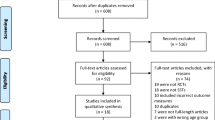Abstract
This article outlines the creation of a dance/movement therapy (DMT) group for Hispanic immigrant women, its rationale, and proposed components. Since immigration is becoming of central interest in the United States and the Hispanic immigrant population is growing rapidly, the needs of this population must be acknowledged, and therapeutic models must be created to support them. Several dance/movement therapists who have explored issues of diversity cite the importance of recognizing and honoring both difference as well as universality. This proposed short-term group for Hispanic immigrant mothers in a school setting includes DMT principles and recognizes the specific needs, clinical issues, and values of this population.
Similar content being viewed by others
References
Ahmed, A., Stewart, D., Teng, L., Wahoush, O., & Gagnon, A. (2008). Experiences of immigrant new mothers with symptoms of depression. Arch Womens Mental Health, 11(4), 295–303. doi:10.1007/s00737-008-0025-6.
Bacallao, M., & Smorowski, P. (2005). “Entre dos mundos” (between two worlds): Bicultural skills training with Latino immigrant families. The Journal of Primary Prevention, 26(6), 485–509. doi:10.1007/s10935-005-0008-6.
Bacallao, M., & Smorowski, P. (2009). Entre dos mundos/between two worlds: Bicultural development in context. The Journal of Primary Prevention, 3(3–4), 421–451. doi:10.1007/s10935-009-0176-x.
Bathum, M., & Baumann, L. (2007). A sense of community among immigrant Latinas. Family Community Health, 30, 167–177.
Baudino, L. (2010). Autism spectrum disorder: A case of misdiagnosis. American Journal of Dance Therapy, 32(2), 113–129. doi:10.1007/s10465-010-9095-x.
Beckerman, N., & Corbett, L. (2008). Immigration and families treating acculturative stress from a systemic framework. Family Therapy, 35, 63–81.
Berry, J. W. (1998). Acculturation stress. In P. B. Organista, K. M. Chun, & G. Marin (Eds.), Readings in ethnic psychology (pp. 117–122). New York: Routledge.
Boas, S. (2006). The body of culture: Transcultural competence in dance movement therapy. In H. Payne (Ed.), Dance movement therapy: Theory, research and practice (2nd ed., pp. 112–131). London: Routledge.
Caldwell, C. (1997). The somatic umbrella. In C. Caldwell (Ed.), Getting in touch: The guide to new body-centered therapies (pp. 7–28). Wheaton: Theosophical.
Caldwell, C. (2010). Diversity issues in movement analysis and assessment. In S. Bender (Ed.), Movement analysis of interaction (pp. 61–78). Berlin: Logos.
Chaiklin, S. (2009). We dance from the moment our feet touch the earth. In S. Chaiklin & H. Wengrower (Eds.), The art and science of dance/movement therapy: Life is dance (pp. 3–12). New York: Routledge.
DeNavas-Walt, C., Proctor, B. D., & Smith, J. C. (2011). U. S. Census Bureau, current population reports: Income, poverty, and health insurance coverage in the United States: 2010 (Report No. P60-239). Washington, DC: U. S. Government Printing Office. Retrieved from http://www.census.gov/prod/2011pubs/p60-239.pdf
Dolin, J. (2007). Long-term group dance movement therapy with mothers of children with special needs. Paper presented at the ADTA Conference Dance/Movement Therapy: New currents, New Bridges, Brooklyn, NY.
Dosamantes-Beaudry, I. (1997). Embodying a cultural identity. The Arts in Psychotherapy, 24(2), 129–135. doi:10.1016/S0197-4556(96)00018-4.
Erfer, T., & Ziv, A. (2006). Moving toward cohesion: Group dance/movement therapy with children in psychiatry. The Arts in Psychotherapy, 33(3), 238–246. doi:10.1016/j.aip.2006.01.001.
Falicov, C. J. (1998). Latino families in therapy: A guide to multicultural practice. New York, NY: Guilford Press.
Farr, M. (1997). The role of dance movement therapy in treating at-risk African American adolescents. The Arts in Psychotherapy, 24(2), 183–191. doi:10.1016/S0197-4556(97)00004-X.
Gonzales, F. (2008, May 14). Hispanic women in the United States, 2007 [Fact sheet]. Washington, DC: Pew Hispanic Center.
Gonzalez-Ramos, G. (1990). Examining the myth of Hispanic families’ resistance to treatment: Using the school as a site for services. Social Work in Education, 12(4), 261–274.
Hanna, J. (1990). Anthropological perspectives for dance movement therapy. American Journal of Dance Therapy, 12(2), 115–126. doi:10.1007/BF00843886.
Hanna, J. (2010). Judy Ryde: Being white in the helping professions: Developing effective intercultural awareness. American Journal of Dance Therapy, 32(2), 144–147. doi:10.1007/s10465-010-9098-7.
Leon, A. M., & Dziegielewski, S. F. (2000). Engaging Hispanic immigrant mothers: Revisiting the time-limited psycho-educational group model. Crisis Intervention, 6(1), 13–27. doi:10.1080/10645130008951293.
Levy, F. J. (2005). Dance movement therapy: A healing art (2nd rev ed.). Reston: American Association for Health, Physical Education, Recreation, and Dance.
Obama, B. (2010, July 1). Obama outlines immigration reform [Video sourced by R. Cripps]. Address presented at American University, Washington, DC. Retrieved from NowPublic website: http://www.nowpublic.com/world/obama-immigration-speech-july-1-quotes-remarks-reform-2635979.html
Pallaro, P. (1997). Culture, self and body self: Dance/movement therapy with Asian Americans. The Arts in Psychotherapy, 24(3), 227–241. doi:10.1016/S0197-4556(97)00038-5.
Pylvänäinen, P. (2008). A dance/movement therapy group as a community outreach for intercultural women in Tokyo. Body, Movement and Dance in Psychotherapy, 3(1), 31–44.
Rashed, M., Rashed, M., & Ho, M. (2004). Family therapy with ethnic minorities. Thousand Oaks: Sage.
Redfield, R., Linton, R., & Herskovits, M. (1936). Memorandum for the study of acculturation. American Anthropologist, 38(1), 149–152. doi:10.1525/aa.1936.38.1.02a00330.
Ruiz, E. (2012). Understanding Latina immigrants using relational cultural theory. Women in Therapy, 35(1–2), 68–79. doi:10.1080/02703149.2012.634727.
Sandel, S., Chaiklin, S., & Lohn, A. (Eds.). (1993). Foundations of dance/movement therapy: The life and work of Marian Chace. Columbia: Marian Chace Memorial Fund of the American Dance Therapy Association.
Santiago-Rivera, A. L., Arredondo, P., & Gallardo-Cooper, M. (2002). Counseling Latinos and la familia. Thousand Oaks: Sage.
Schmais, C. (1985). Healing processes in group dance therapy. American Journal of Dance Therapy, 8(1), 17–36. doi:10.1007/BF02251439.
Smokowski, P., Roderick, R., & Bacallao, M. (2008). Acculturation and Latino family process: How cultural involvement, biculturalism, and acculturation gaps influence family dynamics. Family Relations, 57(3), 295–308. doi:10.1111/j.1741-3729.2008.00501.x.
Tummala-Narra, P. (2004). Mothering in a foreign land. The American Journal of Psychoanalysis, 64(2), 167–181. doi:10.1023/B:TAJP.0000027271.27008.60.
American Dance Therapy Association. (n.d.). About dance/movement therapy. Retrieved from http://www.adta.org/about/who.cfm
U.S. Census Bureau. (2011, March, 24). State and county quickfacts: Allegany County, N.Y. Washington, DC: U.S. Department of Commerce. Retrieved from http://quickfacts.census.gov
U.S. Census Bureau, Public Information Office. (2011, May, 26). 2010 Census shows nation’s Hispanic population grew four times faster than total U.S. population. Retrieved from http://2010.census.gov/news/releases/operations/cb11-cn146.html
Author information
Authors and Affiliations
Corresponding author
Rights and permissions
About this article
Cite this article
de Valenzuela, M.P. Dancing with Mothers: A School-Based Dance/Movement Therapy Group for Hispanic Immigrant Mothers. Am J Dance Ther 36, 92–112 (2014). https://doi.org/10.1007/s10465-014-9166-5
Published:
Issue Date:
DOI: https://doi.org/10.1007/s10465-014-9166-5




